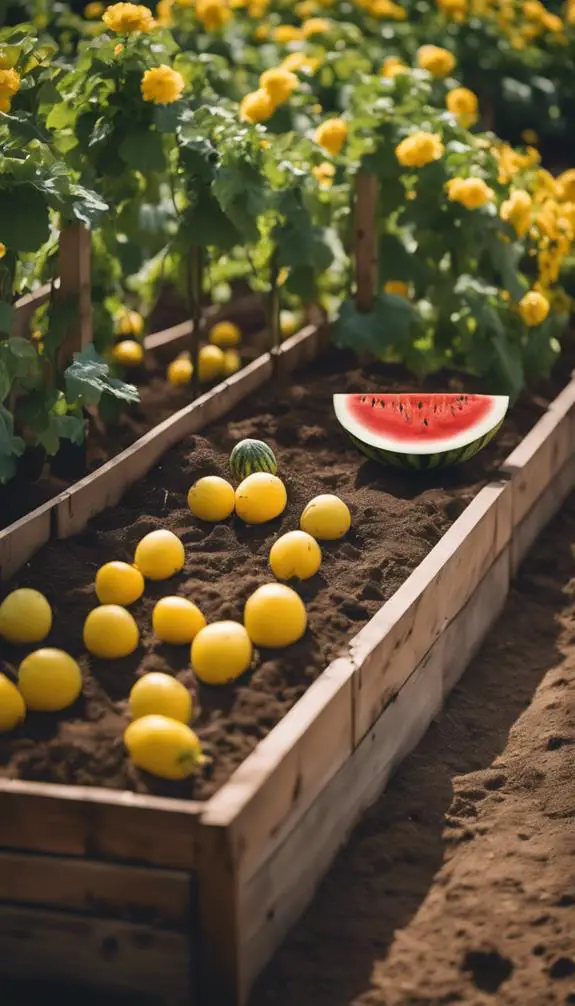When you decide to grow watermelon in raised beds, you're taking the first step towards enjoying a bountiful harvest of sweet and revitalizing fruit. To set yourself up for success, it's vital to start with the right variety – one that's compact or bush-type, specifically bred for smaller spaces. But that's just the beginning. You'll need to prepare your soil, build or select the perfect raised bed, and create a sunny and warm location that fosters growth. With these basics covered, you'll be ready to sow your seeds – but what's the best way to do that, and what comes next?
Summary
- Select compact or bush-type watermelon varieties for raised beds with limited space to ensure proper growth and development.
- Loosen the soil to a depth of 12 inches, test the pH level, and add amendments like compost or manure to create a well-draining and nutrient-rich environment.
- Position the raised bed in a spot that receives full sun, has temperatures above 65°F (18°C), and is oriented east to west for consistent sunlight.
- Sow seeds 1 inch deep and 6 inches apart in warm soil, and maintain ideal soil moisture, keeping the top 2-3 inches of soil consistently moist but not waterlogged.
- Prune vines to encourage bushy growth and promote fruiting, and provide support using trellis systems or fruit cradles to prevent watermelons from breaking off the vine.
Choosing the Right Watermelon Variety

Select a watermelon variety that thrives in raised beds by considering factors like space, growth habit, and desired fruit characteristics.
You'll want to choose a variety that's compact or bush-type, as they're better suited for raised beds with limited space. Consider the growth habit of the variety, as some watermelons are vining and require more room to spread out.
Desired fruit characteristics, such as size, shape, and sweetness, will also impact your variety selection. Look for disease-resistant and heat-tolerant varieties to guarantee a successful harvest.
Research different watermelon types, such as 'Sugar Baby' or 'Yellow Doll', to find the best fit for your raised bed. By carefully selecting a variety, you'll be on your way to growing delicious and healthy watermelons.
Preparing the Raised Bed Soil
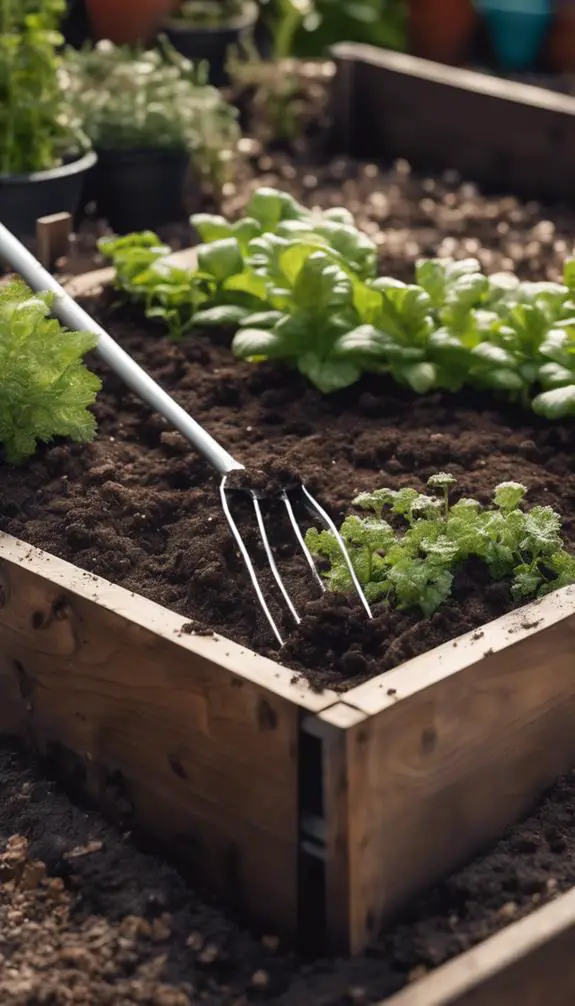
With your watermelon variety chosen, it's time to turn your attention to preparing the raised bed soil.
You'll want to start by loosening the soil to a depth of 12 inches to prevent soil compaction, which can hinder watermelon growth.
Next, test the pH level of your soil and adjust it if necessary, as watermelons prefer a slightly acidic to neutral soil pH (6.0-6.8).
Add soil amendments like compost or well-rotted manure to improve soil structure and fertility.
Mix these amendments into the top 6-8 inches of soil to create a well-draining and nutrient-rich environment for your watermelon plants.
Building or Selecting Raised Beds
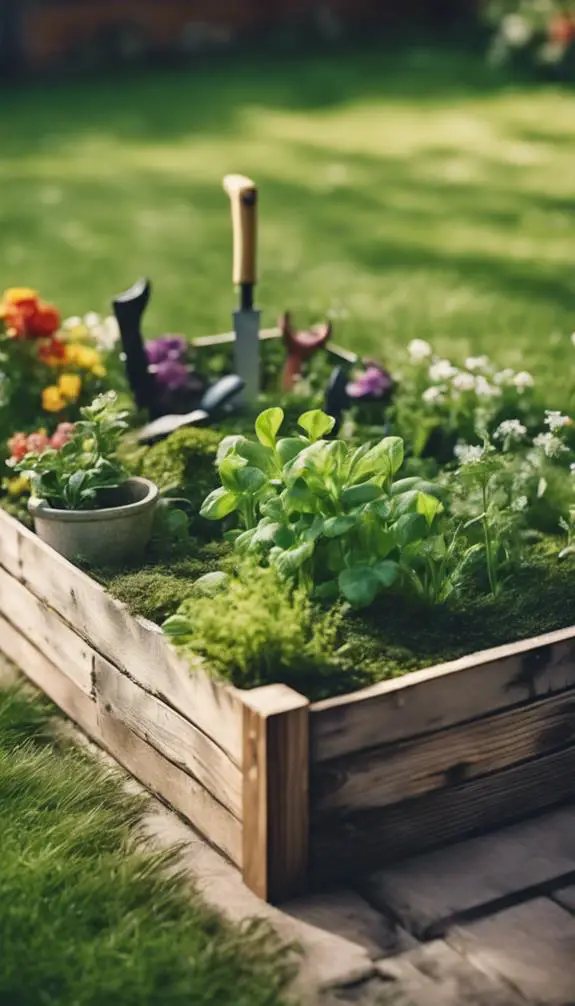
When building or selecting raised beds for growing watermelon, you'll need to ponder the frame material's durability and rot resistance, as well as its potential impact on soil temperature and moisture levels.
You'll also need to determine the ideal bed size, taking into account the mature size of your watermelon plants and the space needed for air circulation and access.
Bed Frame Materials
You have several options for bed frame materials when building or selecting raised beds for growing watermelon.
Wooden frames are a popular choice, offering a natural, rustic aesthetic. They can be made from durable woods like cedar or redwood, which resist rot and insect damage.
Metal borders are another option, providing a sleek, modern look. They're often made from aluminum or steel, which are corrosion-resistant and can withstand heavy loads.
Consider the pros and cons of each material, including durability, maintenance, and cost, to choose the best fit for your watermelon garden.
Bed Size Considerations
The dimensions of your raised bed will substantially impact the growth and productivity of your watermelon vines.
When selecting or building a raised bed, consider the mature size of your watermelon variety. A minimum bed width of 4-6 feet is recommended to accommodate the vine's spread.
Bed depth is also vital, with a minimum of 8-10 inches required for adequate root growth. Don't forget to optimize corner space by using a square or rectangular bed with rounded corners, allowing your vines to grow freely without obstruction.
A well-designed raised bed will provide ample space for your watermelon vines to thrive, resulting in a bountiful harvest.
Creating a Sunny and Warm Location
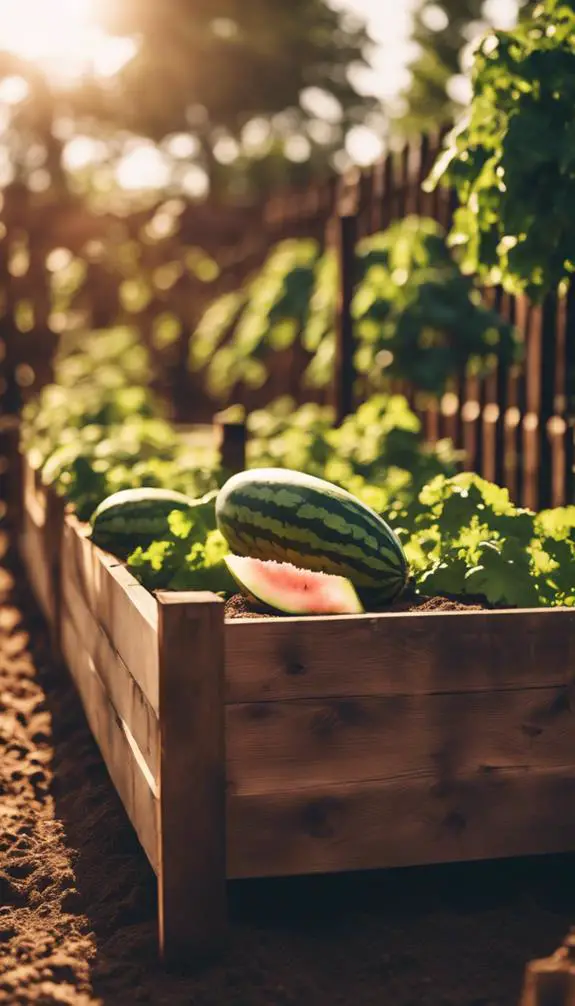
You'll want to position your raised bed in a spot that receives full sun, as watermelon requires at least 6 hours of direct sunlight per day to thrive.
Additionally, the location should be warm, with temperatures above 65°F (18°C) for peak growth.
Guarantee the bed is oriented east to west, as this allows the plants to receive consistent sunlight throughout the day.
Warmth and Sunlight Hours
Growing watermelons demands a location that receives direct sunlight for most of the day, as these heat-loving plants thrive in warm temperatures.
You'll want to choose a spot that gets at least 6 hours of direct sunlight, ideally 8-10 hours for peak growth.
Summer warmth is essential, with ideal diurnal temperatures ranging from 65°F to 85°F (18°C to 30°C).
Certify your raised bed receives consistent warmth by selecting a location with minimal shading.
Avoid areas near trees, buildings, or other structures that may cast shade.
Optimal Orientation Matters
Frequently, ideal orientation is overlooked when creating a sunny and warm location for watermelon plants in raised beds.
You'll want to position your raised bed to maximize sunlight hours, especially during the growing season. A southern exposure is ideal, as it receives direct sunlight for most of the day.
If that's not possible, an eastern slope is the next best option, as it receives morning sun and gentle afternoon shade. Avoid northern exposures, as they receive limited sunlight.
Consider the surrounding landscape and structures that may cast shade on your raised bed. By optimizing the orientation of your raised bed, you'll create a warm and sunny location that promotes healthy watermelon growth.
Sowing Watermelon Seeds Correctly
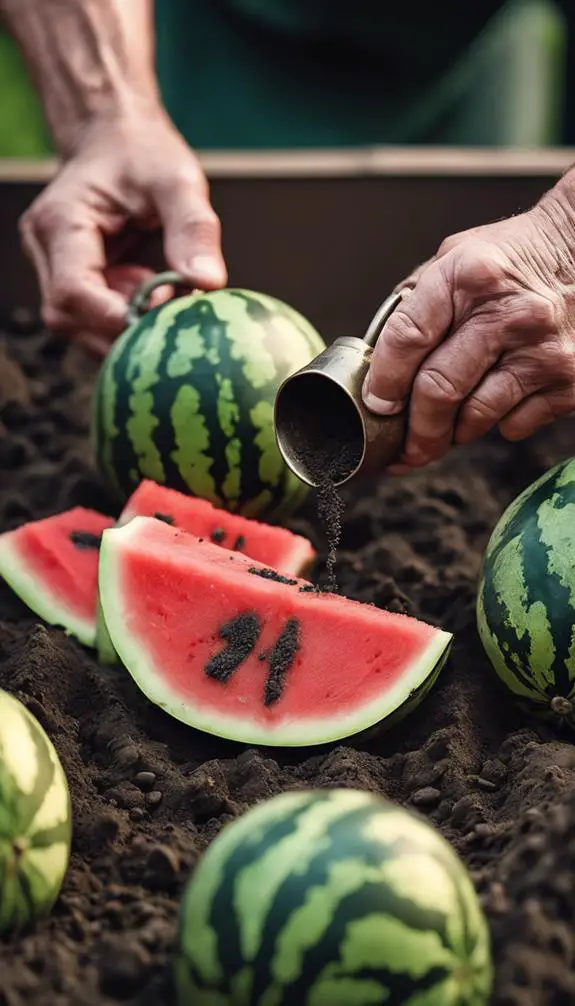
Precision is key when sowing watermelon seeds, as it sets the stage for a successful harvest.
You'll want to sow seeds 1 inch deep and 6 inches apart in warm soil, ideally between 70°F to 85°F (21°C to 30°C) for ideal seed germination.
Soil temperature is vital, as watermelon seeds germinate best when the soil temperature is above 65°F (18°C).
Sow 3-4 seeds per hole, and then thin them out to the strongest two seedlings once they've germinated.
Make sure the raised bed is well-draining and has a pH between 6.0 and 6.8.
Watering and Mulching Techniques

After sowing your watermelon seeds, it's essential to focus on consistent moisture levels to support seedling development.
You'll want to maintain ideal soil moisture, keeping the top 2-3 inches of soil consistently moist but not waterlogged. Check the soil daily, and water when the top inch of soil feels dry to the touch.
Mulching is also pivotal, as it helps retain soil moisture and suppresses weeds. Apply a 2-3 inch layer of organic mulch, such as straw or wood chips, around your plants.
Guarantee the mulch layers are evenly spread and not piled against the plant stems. This will promote healthy growth and prevent moisture loss.
Training the Watermelon Vines

As you've established a consistent moisture level and applied a layer of organic mulch, your watermelon seedlings are now ready to spread out and grow.
To optimize space and promote healthy growth, train your watermelon vines using a trellis system. Install a sturdy trellis near your raised bed, and gently twine the vines around it.
Regularly prune the vines to encourage horizontal growth and prevent overcrowding. Remove any weak or spindly growth, and focus on developing 2-3 strong vines.
This will allow your watermelon plants to receive adequate sunlight and air circulation, resulting in a bountiful harvest. By implementing vine pruning and trellis systems, you'll be able to grow more watermelons in a smaller area, making the most of your raised bed space.
Fertilizing for Optimal Growth

Nutrient-rich soil is the foundation of a thriving watermelon crop, and fertilizing plays a crucial role in achieving peak growth.
To maximize your watermelon's growth, you'll need to confirm your raised bed's soil has the right nutrient balance. Start by conducting a soil analysis to determine your soil's pH level and nutrient content.
Based on the results, you can adjust your fertilization strategy. Aim for a balanced fertilizer with a ratio of 5-5-5 (nitrogen-phosphorus-potassium) and apply it according to the manufacturer's instructions.
You may also consider adding organic matter like compost or manure to enhance soil fertility. By maintaining ideal nutrient levels, you'll be rewarded with robust vines, healthy leaves, and juicy fruit.
Pest and Disease Management
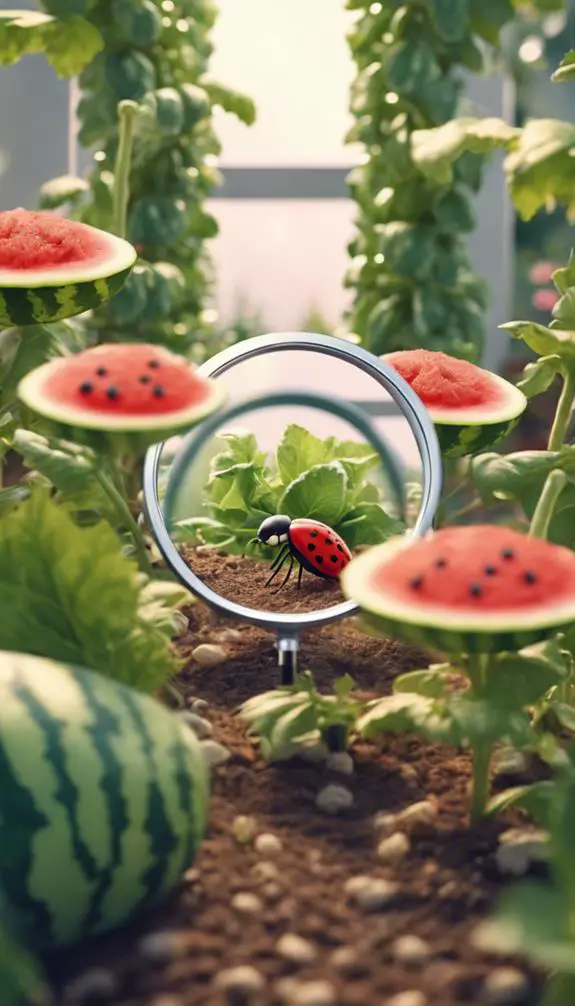
Watermelon vines sprawling across your raised bed are a beautiful sight, but lurking beneath the surface are pests and diseases waiting to wreak havoc on your crop.
To protect your watermelon, you must be proactive in pest identification and disease management. Inspect your plants regularly for signs of infestation or infection, such as holes in leaves, white powdery residue, or black spots on fruit.
Use organic or integrated pest management methods to control pests like aphids, whiteflies, and squash bugs. Select disease-resistant watermelon varieties to reduce the risk of fungal and bacterial infections.
Implement good sanitation practices, like removing weeds and debris, to prevent disease spread. By staying vigilant and taking preventative measures, you can minimize losses and enjoy a healthy, productive watermelon harvest.
Pruning for Better Fruit Production
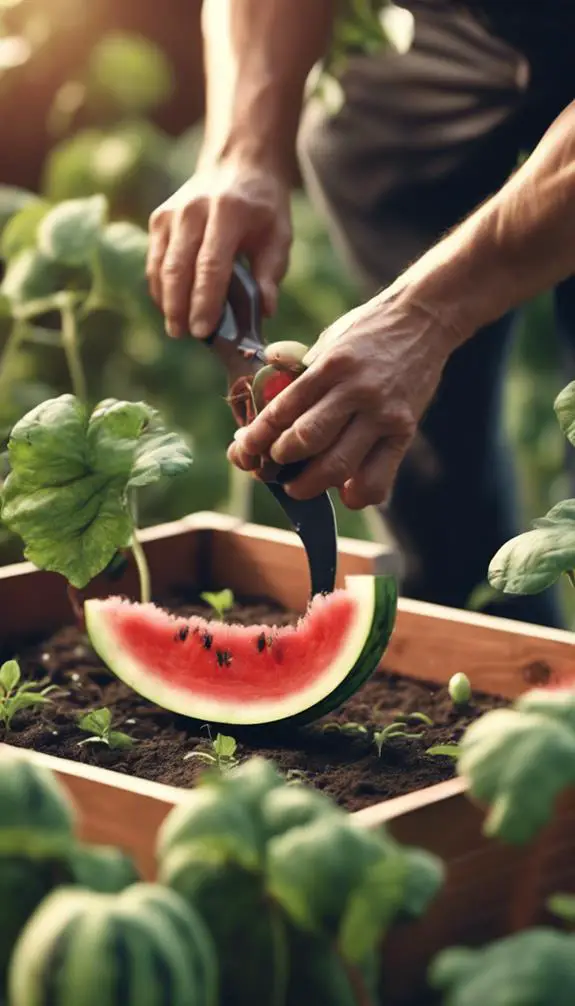
While protecting your watermelon crop from pests and diseases is vital, another key factor in achieving a bountiful harvest is pruning.
You'll want to focus on two main areas: vine pruning and fruit thinning. Vine pruning involves trimming back the watermelon vines to encourage bushy growth and promote fruiting. Remove any weak or spindly growth, and trim the tips of the vines to encourage branching.
Fruit thinning is the process of removing select fruits to allow the remaining ones to grow larger and sweeter. Remove any misshapen or small fruits, leaving about 6-8 inches between each remaining fruit. This will give your watermelons the space they need to grow to their full potential.
Providing Support for Heavy Fruits

As your watermelons begin to swell, providing adequate support becomes crucial to prevent them from breaking off the vine or developing flat spots.
You'll need to install a trellis system or a fruit cradle to keep your fruits elevated and secure. Trellis systems work by training the vines to climb up a vertical structure, allowing the fruit to hang down and receive prime sunlight.
Fruit cradles, on the other hand, provide individual support to each fruit, keeping them off the ground and promoting even growth. Both methods guarantee your watermelons receive the necessary support to grow into perfect spheres.
Monitoring for Watermelon Ripeness

Harvest time is approaching, and it's crucial to monitor your watermelons for ripeness to guarantee you pick them at the peak of sweetness and flavor.
You'll need to check for ripeness signs, including a creamy yellow or white spot on the underside, which indicates where the fruit rested on the soil.
The skin should be glossy and smooth, with no soft spots or bruises.
Use the tapping technique to check for ripeness – a ripe watermelon will have a deep, hollow sound when tapped gently with your knuckles.
Avoid tapping too hard, as this can damage the fruit.
Regularly monitoring your watermelons will certify you harvest them at the prime time, resulting in a juicy and sweet treat.
Harvesting and Storing Watermelons

When you've confirmed your watermelons are ripe, this is vital to harvest them quickly to preserve their quality and flavor.
Delayed harvest timing can lead to a decrease in watermelon sweetness and overall quality. Cut the stem carefully with a sharp knife or pruning shears, leaving about 1 inch of stem attached to the fruit.
Handle the harvested watermelons gently to avoid bruising or scratching. Store them at room temperature, away from direct sunlight, until consumption.
If you need to store them for an extended period, keep them at 50-60°F (10-15°C) with high humidity. Proper harvesting and storage techniques will guarantee you enjoy your homegrown watermelons at their best.
FAQs
Can I Grow Watermelon in Partial Shade?
You can grow watermelon in partial shade, but be aware it'll require more days to mature; watermelons need at least 6 hours of direct sunlight, so guarantee your shaded spot receives sufficient sunlight hours to promote ideal growth.
Will Watermelon Plants Grow in Acidic Soil?
You'll find that watermelon plants can tolerate a wide soil pH range, but they thrive in slightly acidic to neutral conditions, between 6.0 and 6.8; however, they can still grow in acidic soil with pH as low as 5.5, although yields may suffer.
Can I Use Containers Instead of Raised Beds?
You can definitely use containers instead of raised beds, but guarantee they're large enough, with a minimum container size of 5-7 gallons and a soil depth of at least 6-8 inches to accommodate watermelon roots.
How Often Should I Rotate My Watermelon Crop?
You'll want to rotate your watermelon crop every 2-3 years to avoid depleting soil nutrients and promoting pest buildup. Proper soil preparation, including adding organic matter and crop-specific fertilizers, is vital for a successful rotation.
Will Watermelon Plants Attract Beneficial Insects?
You'll attract pollinator friends to your watermelon plants, as they're natural bee magnets; their bright yellow flowers will draw beneficial insects, enhancing pollination and fruit set, while also supporting local biodiversity.
Conclusion
You've successfully grown watermelon in your raised bed by following these steps. Now, enjoy the fruits of your labor!




